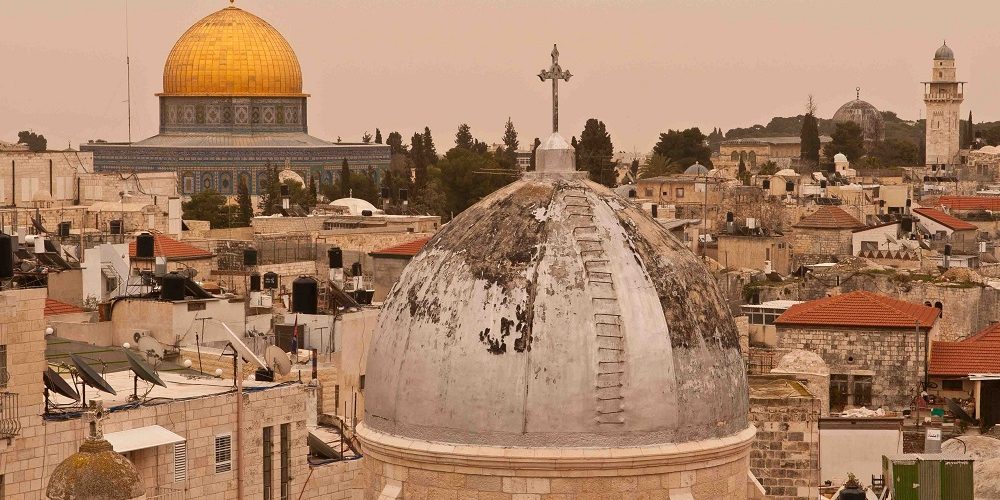Jerusalem, the birthplace and spiritual home for the 3 major Abrahamic religions, is considered to be one of the oldest cities in the world while archeological evidence suggests that Jerusalem was established around 3000 BC (5000 years ago). During its long history, Jerusalem has been destroyed at least twice, besieged 23 times, attacked an additional 52 times, and captured and recaptured 44 times, according to Eric H. Cline’s tally in Jerusalem Besieged. Jewish Jerusalem was founded 3000 years ago when King David captured it from the Jebusite and made it the capital of the United Kingdom of Israel. His son King Solomon commissioned the building of the first Temple as the home for the Divine Presence on Mount Moriah, which is also called the Temple Mount.
[recommend-gallery]According to Biblical sources, this is where Abraham prepared to sacrifice his only son, Isaac, to God. According to Muslim belief, it is from the same rock on which Abraham prepared to sacrifice Isaac that Muhammad ascended to heaven. This is the site of the Dome of the Rock, which is one of the holiest sites to Muslims all over the world. The Dome of the Rock is located at the visual center of a platform known today as the Temple Mount. It was constructed on the site of the Second Jewish Temple, which was destroyed during the Roman Siege of Jerusalem in 70 CE.
As we can see, Jerusalem has clearly “changed many hands” over its long history. The following is a brief description of the most important ones:
- Proto-Canaanite Period – the first settlement in Jerusalem, which was established near Gihon Spring around 4500 – 3500 BC. The first mention of the city was in the Book of Genesis 14:18 as a city called “Salem”.
- Canaanite and New Kingdom Egyptian Period – archeological evidence suggests that by the 17th century BCE, the Canaanites had built massive walls on the eastern side of Jerusalem in order to protect their ancient water system. By 1550 – 1400 BC, Jerusalem had become a vassal to Egypt.
- Independent Israel and Judah (house of David) Period – according to the Bible, Jerusalem become the capital of the United Kingdom of Israel around 1000BCE when King David captured Jerusalem from the Jebusites. According to the Bible, King David chose Jerusalem as the capital of his Kingdom since it was not the capital of any of the 12 Tribes of Israel at the time. Jerusalem remained the capital of the Kingdom of Israel and Judah for some 400 years.
- Neo-Babylonian Empire Period – in the year 597 BCE, Jerusalem fell in the hands of the Babylonians and in the year 586 BCE, Jerusalem was completely destroyed – including the first temple – by Nebuchadnezzar (the Babylonian king) after a failed rebellion in Judah. Moreover, most of the Jewish population was exiled to Babylon and some of them fled to Egypt.
- Persian Empire Period – When the Persian Empire conquered Babylonia, Cyrus II of Persia allowed the Jews to return to Jerusalem and rebuild the Temple, the construction of which was completed in 516 BC.
- Hellenic Kingdoms Period – After Alexander the Great conquered the Persian the New Testament, Jerusalem is where Jesus was sentenced to death, crucified and resurrected. It was also in Jerusalem that the Apostles of Christ received the Holy Spirit at Pentecost and first began preaching the Gospel and proclaiming his resurrection. In 66 CE the Jewish population rebelled against the Roman Empire in what is now known as the Great Revolt. Roman legions under future emperor Titus reconquered and subsequently destroyed much of Jerusalem and the Second Temple in 70 CE. After this revolt, Jews continued to live in Jerusalem in significant numbers and were allowed to practice their religion only if they paid the Jewish Tax.
- Roman Aelia Capitolina Period – In 135 CE, Roman Emperor Hadrian rebuilt much of the city of Jerusalem – now know as the Old City of Jerusalem – as a pagan city called Aelia Capitolina. Hadrian also placed restrictions on some Jewish practices, which caused a revolt by the Judeans, led by Simon Bar Kokhba. Hadrian responded with overwhelming force, putting down the rebellion, killing as many as a half million Jews, and resettling the city as a Romancolonia. Jews were forbidden to enter the city. For the next 150 years, Jerusalem remained a relatively unimportant pagan Roman town.
- Byzantine Empire Period – The Byzantine Emperor Constantine, however, rebuilt Jerusalem as a Christian center of worship, building the Church of the Holy Sepulchre in 335. Jerusalem had received special recognition in Canon VII of the First Council of Nicaea in 325. Constantine’s mother, Helena, made a pilgrimage to the city and claimed to have recovered the cross of Christ.
- Middle Ages Period – In the year 636, Jerusalem was conquered for the first time by the Muslims who built the Dome of the Rock on top of the Temple Mount. The is the site from which, according to Islam, Muhammad ascended to heaven on a Night Journey, or Isra and Miraj. In the year 1099, Jerusalem was captured by the first Crusaders and thus returned to Christian control for 100 years in two periods. 1097 – 1187, which ended when Saladin conquered Jerusalem and was captured again by the Crusaders back in 1229 for another period of 16 years until the Mamluk captured the entire Land of Israel in 1244. During the first period, 1097 – 1987 Christian settlers from the West set about rebuilding the principal shrines associated with the life of Christ. The Church of the Holy Sepulchre was ambitiously rebuilt as a great Romanesque church, and Muslim shrines on the Temple Mount (the Dome of the Rock and the al-Aqsa Mosque) were converted for Christian purposes.
- The Ottoman EmpirePeriod – In 1517, Jerusalem was taken over by the Ottoman Empire and enjoyed a period of renewal and peace under Suleiman the Magnificent, including the construction of magnificent walls of what is now known as the Old City of Jerusalem. The rule of Suleiman and the subsequent Ottoman Sultans brought an age of “religious peace”; Jew, Christian and Muslim enjoyed the freedom of religion the Ottomans granted them and it was possible to find a synagogue, a church and a mosque in the same street. In the mid-19th century, with the decline of the Ottoman Empire, the city was a backwater, with a population that did not exceed 8,000. Nevertheless, it was, even then, an extremely heterogeneous city because of its significance to Judaism, Christianity, and Islam. The population was divided into four major communities – Jewish, Christian, Muslim, and Armenian – and the first three of these could be further divided into countless subgroups, based on precise religious affiliation or country of origin. The Church of the Holy Sepulchre, which was meticulously partitioned between the Greek Orthodox, Catholic, Armenian, Coptic, and Ethiopian churches. Tensions between the groups ran so deep that the keys to the shrine and its doors were safeguarded by a pair of ‘neutral’ Muslim families. Jerusalem remained under Ottoman rule until it was captured by the British during World War I.
- British Mandate Period – The British controlled Jerusalem from their victory over the Turks in the Middle East during World War I until the establishment of the State of Israel in 1948. British rule marked a period of growing unrest. Arab resentment at British rule and the influx of Jewish immigrants (by 1948 one in six Jews in Palestine lived in Jerusalem) boiled over in anti-Jewish riots in Jerusalem in 1920, 1929, and the 1930s that caused significant damage and several deaths. On November 29, 1947, the United Nations General Assembly approved a plan which partitioned the British Mandate of Palestine into two states: one Jewish and one Arab, whereby Greater Jerusalem would fall under international control.
- Division between Jordan and Israel (1948 – 1967) Period – Following the Arab-Israeli War in 1948, Jerusalem was divided in 2: the eastern half, including the Old City of Jerusalem, was annexed by Jordan while the western half became part of the newly formed State of Israel. However, Jordan breached its commitment to appoint a committee to discuss, among other topics, free access of Jews to the holy sites under its jurisdiction, mainly the Western Wall and the important Jewish cemetery on the Mount of Olives, as provided in Article 8.2 of the Cease Fire Agreement between Jordan and Israel dated April 3, 1949.
- Israeli Period – during the Six-Day War, East Jerusalem was captured by the Israel Defense Forces. Under Israel control, members of all religions are largely granted access to their holy sites.
Now, Let’s All Live the Jerusalem Experience ! ! !





